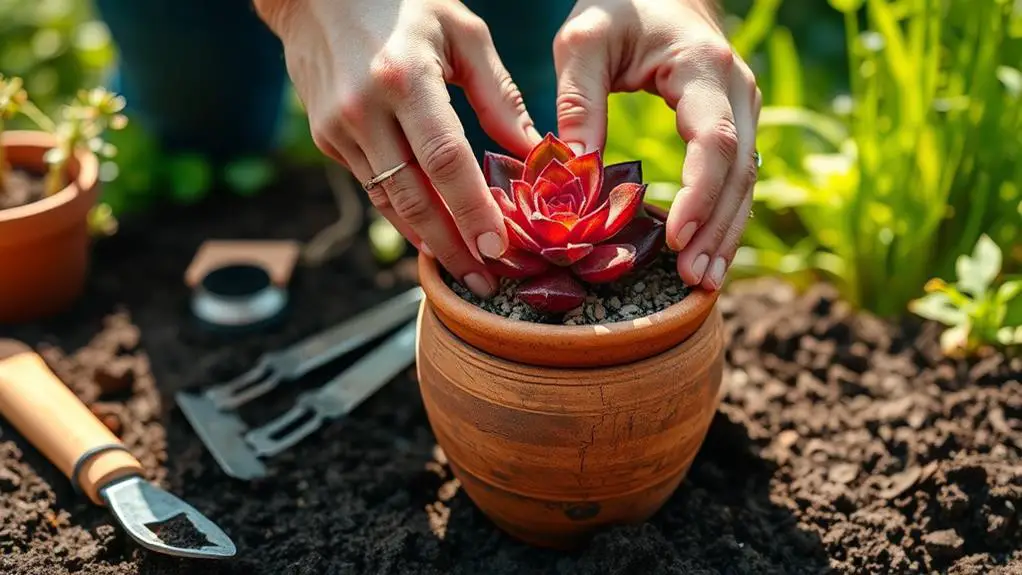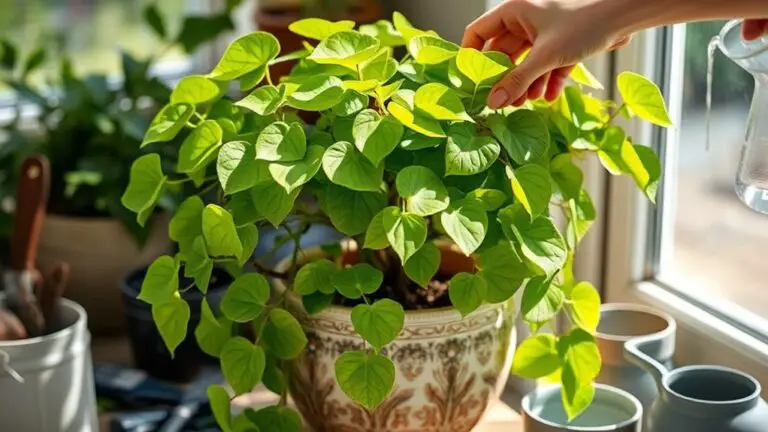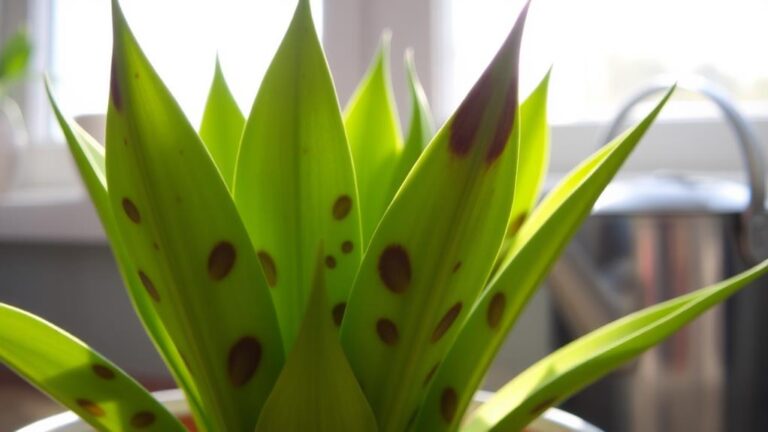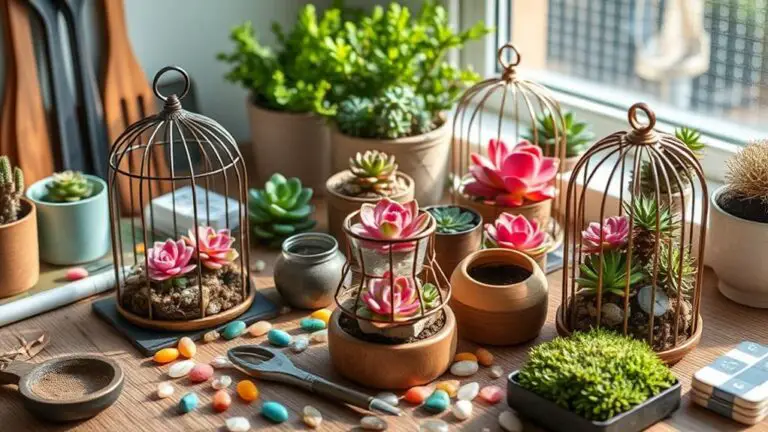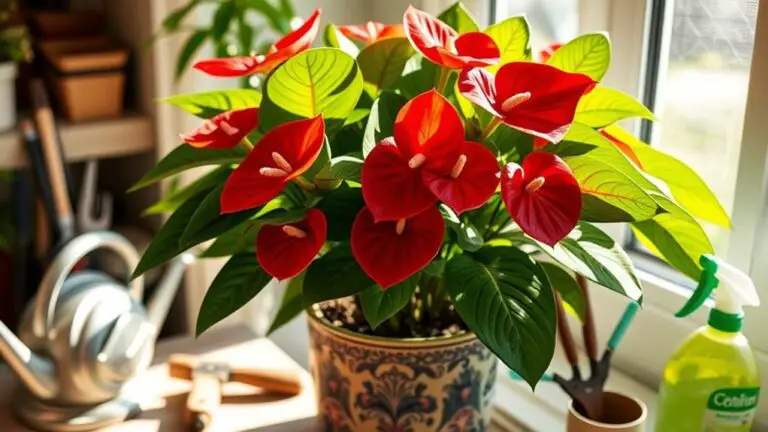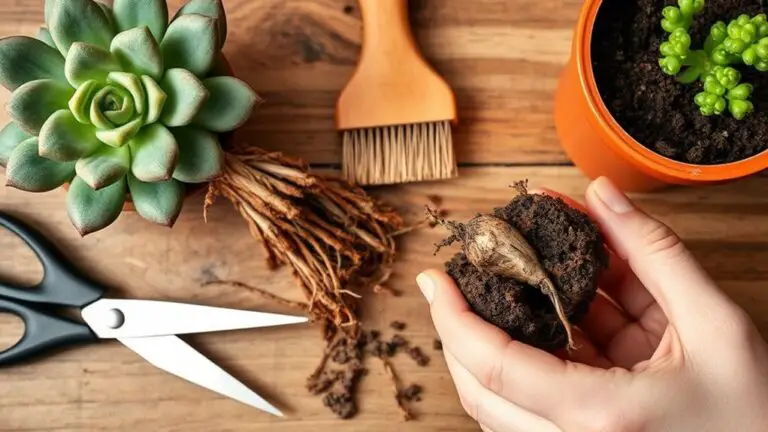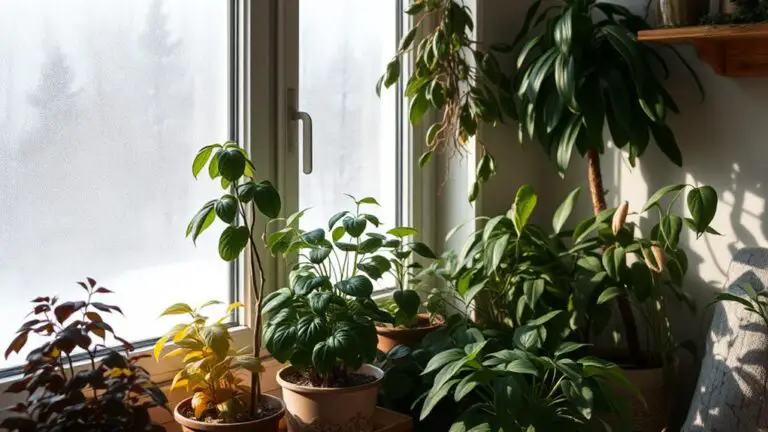10 Essential Tips for Taking Indoor Succulents Outside This Summer
Shifting your indoor succulents to the outdoors can boost their growth and vibrancy, but you'll need to take a few important steps to guarantee they thrive. Start by moving them outside only after the last frost when temperatures are reliably warm. It's vital to gradually acclimate them to the brighter light conditions to avoid sunburn. Place them in semi-shaded areas at first, and slowly increase their exposure over time. Additionally, you'll want to reflect on their watering needs and the type of soil you use. Curious about the specifics for each step? Let's look into how you can make this a smooth shift for your succulents.
Benefits of Outdoor Transition
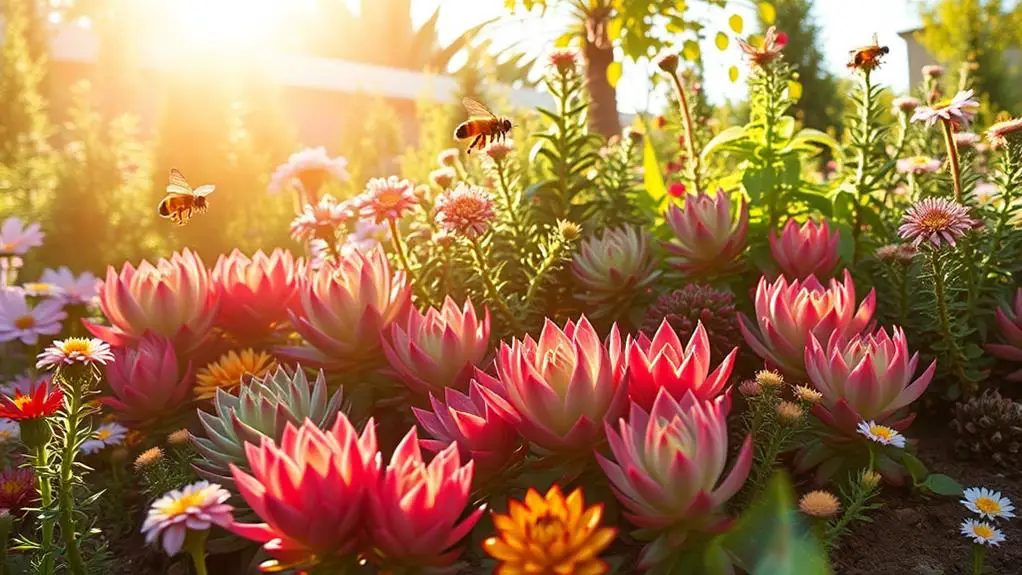
When you take your indoor succulents outside, the benefits are immediate and noticeable. The high light conditions outdoors not only enhance their growth but also bring out vibrant colors in the plants. You'll see less stretching, resulting in healthier and more compact succulents. The increased sunlight exposure is a key factor in meeting the light requirements of your plants, making them look their best.
Acclimating succulents to outdoor conditions can greatly improve their overall health. The warmth of summer helps them adapt more easily, allowing them to flourish during these months. As your succulents adjust to their new environment, you'll notice they become more resilient and vibrant, thriving under natural conditions.
Outdoor conditions also enhance the natural behaviors of succulents. They'll develop stronger roots and better water retention, making for a rewarding gardening experience. Your plants will become more robust and capable of handling various weather conditions.
In short, moving your indoor succulents outside brings numerous benefits. You'll enjoy seeing your plants grow stronger and more colorful. This simple change will make a big difference in your gardening success, offering more satisfaction and healthier plants.
Timing for Outdoor Transition
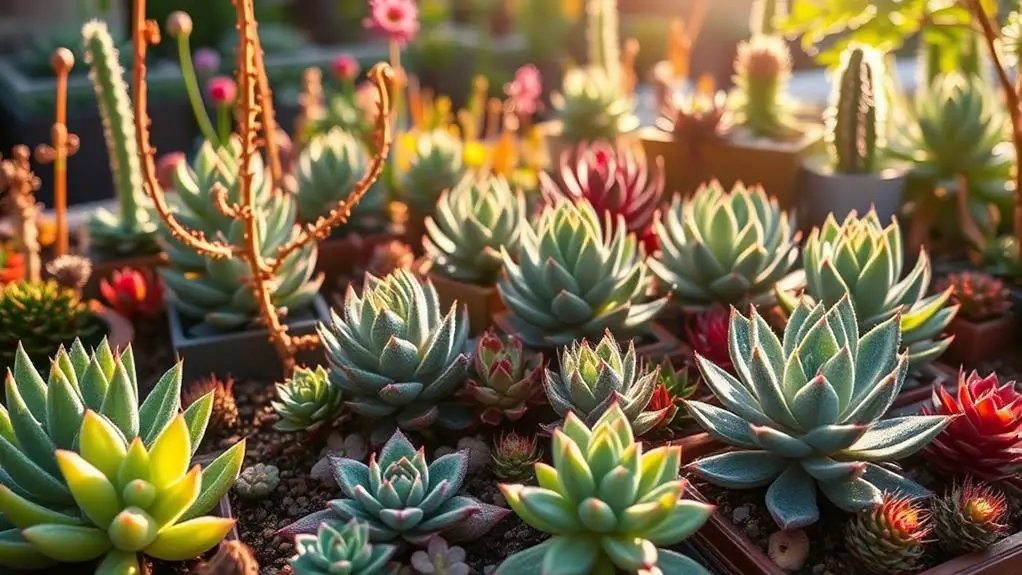
Timing the movement of your indoor succulents to the outdoors is vital for their successful acclimatization.
You'll want to move your succulents outside after the last frost, which for most regions with four seasons, is typically in early to mid-May. Ensuring that temperatures are consistently above 40°F (4°C) during the day and above 59°F (15°C) at night is important for their ideal shift.
To make this process smoother, follow these steps:
- Monitor local weather patterns: Keep an eye out for sudden temperature drops.
- Start when temperatures are between 40°F to 80°F (4°C to 27°C): This range allows your succulents to adjust comfortably.
- Gradually move them outdoors: Begin by placing them outside during the day and bringing them back inside at night for the first week.
- Avoid exposing them to harsh elements: Protect them from heavy rain and strong winds initially.
Research Light Requirements
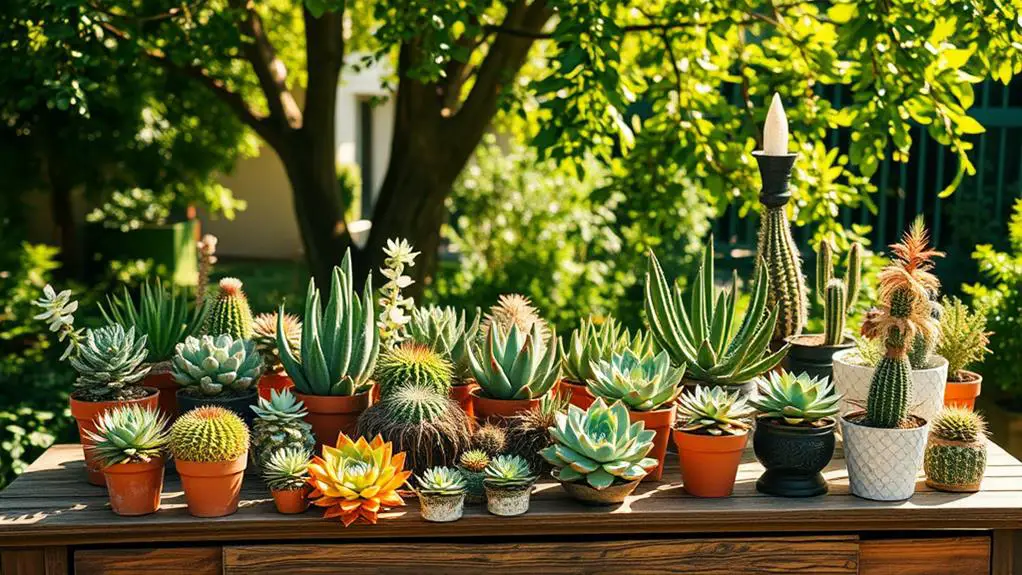
Understanding the light requirements of your succulents is essential for their successful shift outdoors. Different species have varying needs, with some loving bright direct sunlight and others preferring indirect light. Research light requirements for each type of succulent you have to make sure they don't suffer from plant shock when you move them outside.
Outdoor light is much stronger than indoor light, so you need to be careful to avoid sunburn on the leaves. Gradual exposure is key. Start by placing your succulents in a shaded area and then slowly increase their sunlight exposure by 1-2 hours each week. This will help your succulents thrive without causing stress or damage.
Larger, established succulents can handle more light than newly planted ones. Newer plants should stay in shaded spots longer until they're strong enough for more direct light.
Keep an eye out for signs of sunburn, like brown or bleached patches on the leaves, and adjust their placement as needed.
Initial Outdoor Exposure

To guarantee your indoor succulents change smoothly to outdoor conditions, begin by placing them outside during the day once temperatures consistently stay above 15 degrees Celsius.
This initial outdoor exposure helps prevent cold shock and allows your plants to gradually adjust to the new environment. Start by placing your succulents in a semi-shaded area. Direct sunlight can cause leaf burn, so it's crucial to protect them during the first few days.
Limit the initial outdoor exposure to just a few hours a day. Over the course of a week, you can gradually increase the duration to help your succulents acclimatize.
Remember to monitor local weather conditions closely. Sudden changes or extreme temperatures can stress your plants, so being vigilant is key.
During the initial exposure period, bring your succulents back indoors at night. This further reduces the risk of cold shock and guarantees a smoother change.
Here are a few tips to keep in mind:
- Start with semi-shaded areas to protect from leaf burn.
- Limit exposure to a few hours initially and increase slowly.
- Bring plants indoors at night to avoid cold shock.
- Monitor weather conditions to prevent stress.
Gradual Light Adjustment

As you continue shifting your succulents outdoors, gradually increasing their light exposure is essential for their health. Start by placing your succulents in a semi-shaded area. This helps minimize the risk of leaf burn from the intense sunlight. Succulents can be sensitive, so it's important to be gentle as they get used to the outdoors.
Gradual light adjustment is key. Increase their sunlight exposure by just 1-2 hours each week. This slow increase helps your plants acclimate without suffering from sunburn. Avoid placing them in direct sunlight during the afternoon in the initial phase as this can be particularly harsh and damaging.
Throughout this process, monitor the plants closely. Watch for signs of stress such as bleaching or changes in color. These are indicators that they might be getting too much light too quickly. If you notice these signs, adjust their placement to guarantee they're getting the right amount of light.
Aim for a change period of about one week before exposing your succulents to full sunlight. This gives them enough time to adapt to the increased light intensity.
With patience and careful monitoring, your succulents will thrive in their new outdoor environment.
Watering and Soil Management
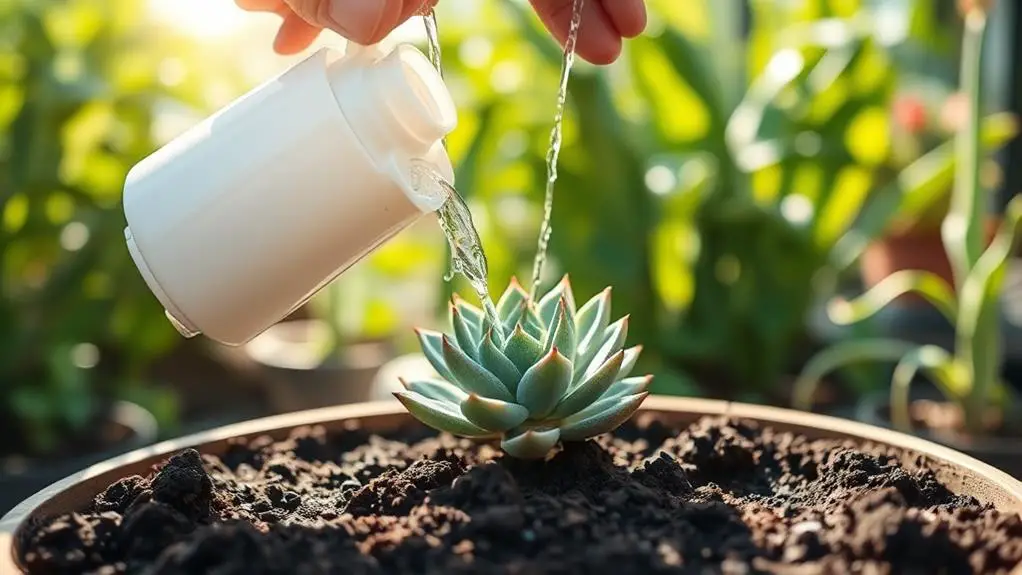
After successfully adjusting your succulents to outdoor light, it's time to focus on watering and soil management to guarantee they thrive in their new environment.
Outdoor succulents generally need watering every 10 days to 2 weeks. Always use pots with drainage holes to avoid waterlogging, which is vital for healthy roots.
Assess soil moisture by inserting your finger an inch deep into the soil. If it feels dry, it's time to water.
Watering should be done early morning or late afternoon. This timing helps optimize absorption and prevent root rot. Make sure your pots have well-draining soil, especially during hot months, to keep excess moisture from accumulating around the roots.
Here are some essential tips to keep your succulents healthy:
- Check soil moisture: Insert your finger an inch deep. If dry, water.
- Use pots with drainage holes: Prevents water from sitting at the roots.
- Water every 10-14 days: Adjust if your environment is particularly hot or cool.
- Water early or late: Helps the water doesn't evaporate too quickly and helps prevent disease.
Focusing on these tips will help your succulents adapt smoothly to their new outdoor life, keeping them vibrant and healthy.
Fertilization Practices
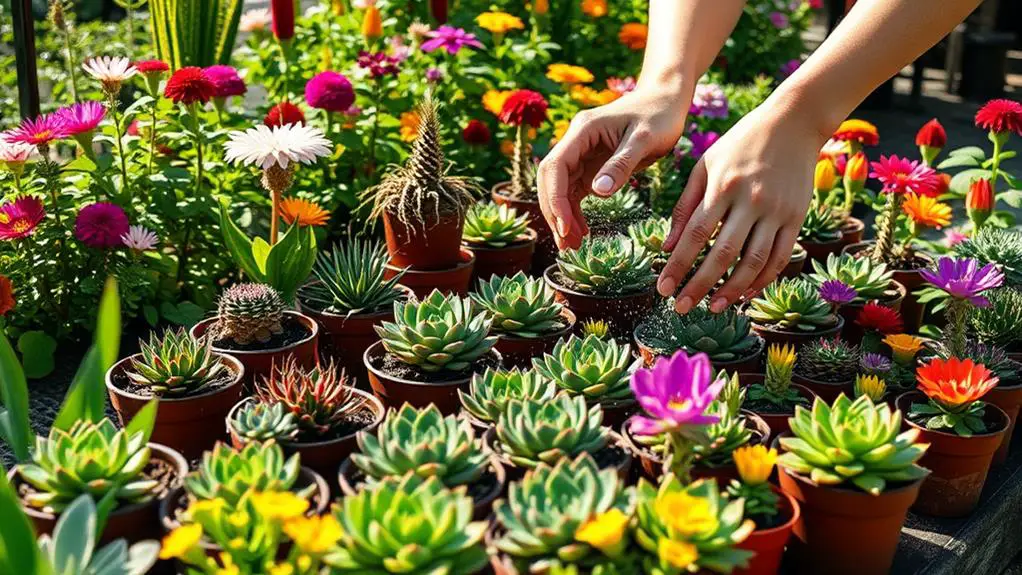
Spring is the perfect time to start fertilizing succulents as they wake up from dormancy, encouraging fresh growth and vibrant colors.
Use diluted commercial fertilizers at half strength to avoid harming your plants, or consider natural options like worm castings for a gentler approach.
Apply fertilizer every 4-6 weeks during the growing season to keep your succulents healthy and strong as they face outdoor conditions.
Optimal Fertilization Timing
Fertilizing your succulents at the right time can make a significant difference in their health and vibrancy. Spring is the ideal time for peak fertilization timing, as your succulents are exiting dormancy and entering their active growth phase. During this period, they need essential nutrients to support healthy new growth and vibrant colors.
To guarantee your succulents get the most out of their fertilization, follow these tips:
- Dilute commercial fertilizers: This prevents burning the plants, ensuring they get nutrients without harm.
- Apply a thin layer of worm castings: These provide essential nutrients and minerals while minimizing the risk of over-fertilization.
- Fertilize every 4-6 weeks: This regular schedule during the growing season supports succulent care and overall plant health.
- Give a good soak after fertilizing: Watering thoroughly helps distribute the nutrients evenly throughout the soil.
Proper nutrition through fertilization enhances your succulents' resilience against summer stressors, promoting overall plant health.
By following these tips and maintaining a regular fertilization schedule, your succulents will thrive as they shift from indoor to outdoor environments.
Nutrient-Rich Additives
When it comes to nutrient-rich additives for your succulents, incorporating them into your fertilization practices can greatly boost plant health and vigor. The first step to care for succulents is understanding their unique needs. Spring is the best time for fertilizing, as succulents exit dormancy and start growing. To avoid burning your plants, always use diluted commercial fertilizers at a quarter of the recommended strength.
Worm castings are an excellent nutrient-rich additive. They improve soil quality and provide essential nutrients without the risk of over-fertilization. Just add a thin layer of worm castings on the soil surface. This method supports growing succulents, giving them vibrant colors and resilience against stressors. Fertilizing every 4-6 weeks during the growing season is preferable.
Here's a quick guide to help you:
| Nutrient-rich Additive | Benefits |
|---|---|
| Worm Castings | Enhances soil quality |
| Diluted Commercial Fertilizer | Promotes healthy growth |
| Spring Application | best time for new growth |
| Thin Layer Application | Prevents over-fertilization |
| Every 4-6 Weeks | Supports vibrant colors & health |
Frequency and Application
Timing and technique are essential when it comes to fertilizing your succulents. To support healthy growth and vibrant colors, you should fertilize your succulents with a diluted commercial fertilizer or worm castings every 4-6 weeks during the growing season.
Spring is the perfect time to start, as your succulents will be coming out of dormancy and need extra nutrients to thrive outdoors.
Applying a thin layer of worm castings to the soil surface is a great way to give your plants essential nutrients without risking over-fertilization. This promotes robust growth and helps your succulents become more resilient to summer stressors like high temperatures and increased sunlight.
Here are some key points to keep in mind:
- Frequency: Every 4-6 weeks during the growing season.
- Application: Use diluted commercial fertilizer or worm castings.
- Timing: Start in spring as succulents exit dormancy.
- Monitoring: Watch how your plants respond and adjust as needed.
Regular feeding will make your succulents stronger and better able to handle the outdoor environment.
Remember to monitor their response and adjust your fertilization practices based on their individual needs and the conditions they're in.
With the right care, your succulents will flourish outside this summer!
Importance of Pot Feet
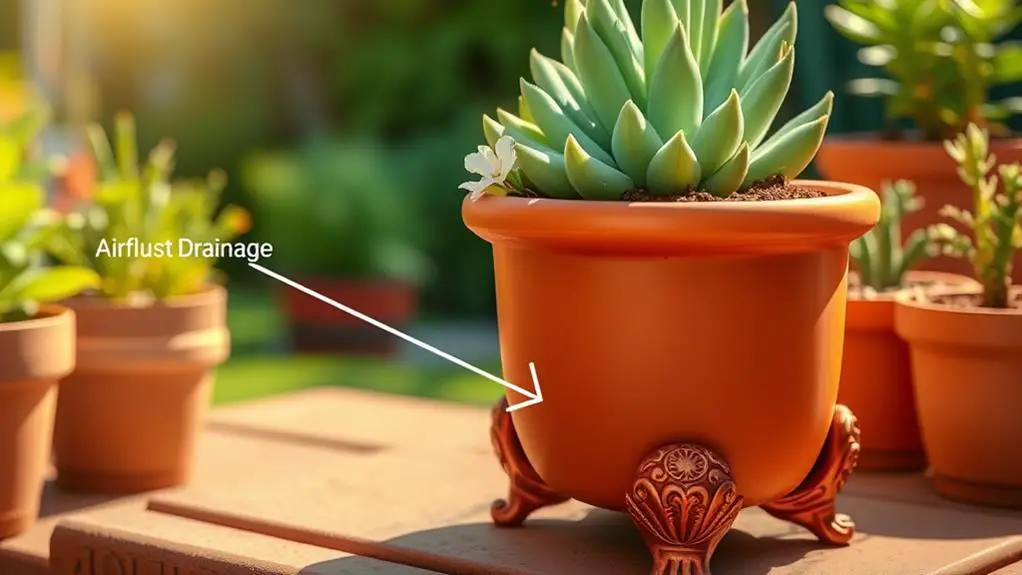
Pot feet are essential for keeping your succulents healthy when you move them outdoors. They elevate your succulent pots, enhancing drainage and airflow around the roots. Good drainage is critical for preventing root rot, a common issue with succulents.
By lifting the pots, pot feet allow excess water to escape more easily, preventing the soil from becoming waterlogged during heavy rain or watering. This helps reduce the risk of fungal diseases.
When you use pot feet, you create space for the soil to dry out more efficiently. This promotes healthier root systems by maintaining ideal moisture levels, which is key for succulents that are sensitive to overwatering.
The improved airflow around the elevated pots also helps keep the roots healthy and strong.
Incorporating pot feet into your succulent care routine can lead to improved growth and health, especially during the outdoor summer months. Your succulents will thrive with the extra drainage and airflow provided by pot feet.
Pest Management
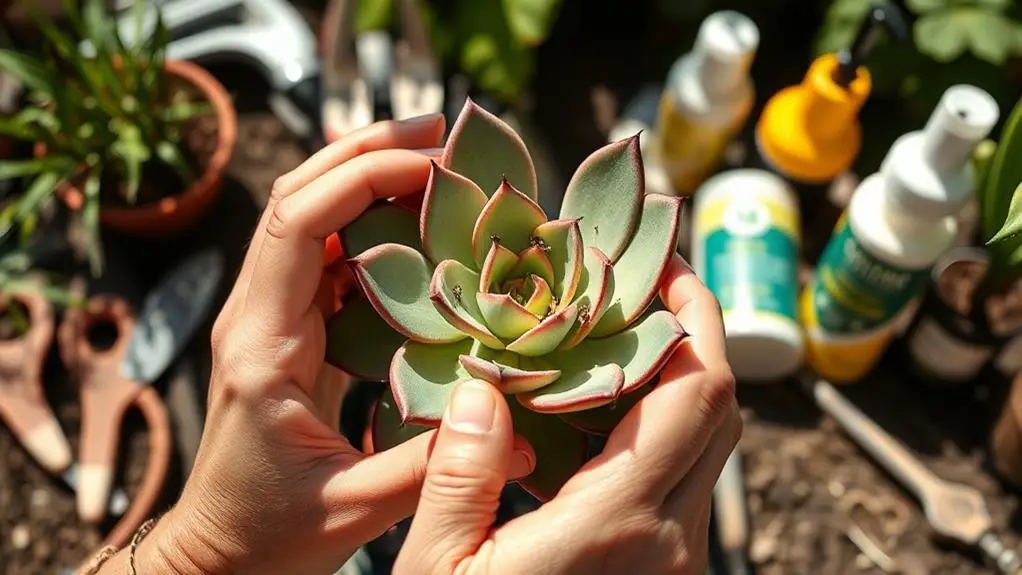
Managing pests is essential to keeping your succulents vibrant and healthy when they're moved outdoors. One common pest you might encounter is mealy bugs. These pests are easy to spot with their white, fluffy appearance on leaves and stems. Regular inspection is key.
If you find mealy bugs, treat the infestation using isopropyl alcohol or insecticidal soap. Apply it directly to the affected areas and move your plants out of direct sunlight to prevent sunburn.
You'll also need to monitor for signs of other pests like spider mites and aphids. These tiny insects can cause a lot of damage if not managed promptly. Acting quickly helps maintain your succulents' health.
Keeping the area around your succulents clean and free of debris reduces the risk of pest infestations. A tidy environment encourages healthy growth and makes it easier to spot problems early.
Consider using physical barriers, like netting, to keep larger pests, such as rodents and birds, at bay.
- Inspect your succulents regularly for mealy bugs
- Treat infestations with isopropyl alcohol or insecticidal soap
- Monitor for signs of spider mites and aphids
- Keep surrounding areas clean and free of debris
Monitoring and Care
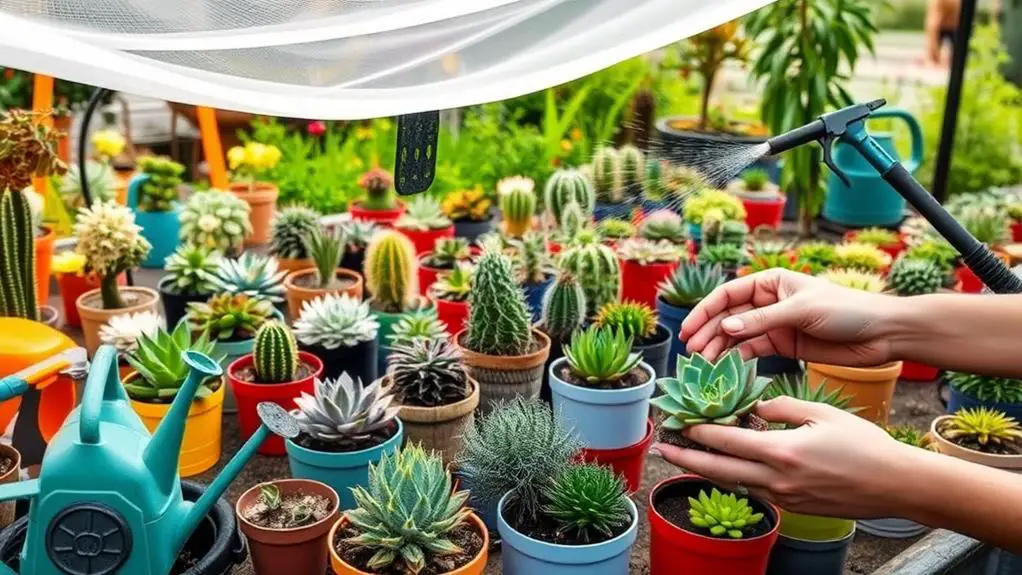
After addressing pest management, it's equally important to focus on monitoring and caring for your succulents once they're outdoors.
Begin by regularly checking for signs of stress or damage, like sunburn or wilting leaves. If you spot any issues, adjust the placement of your succulents to guarantee they receive the right amount of sunlight and shade.
Next, keep a close eye on soil moisture levels. Outdoor succulents usually need watering every 10 days to 2 weeks, depending on temperature and humidity. Overwatering can lead to root rot, so it's vital to monitor moisture carefully.
Inspect your plants frequently for pests such as mealybugs or snails. These pests can easily thrive outside, so early detection and treatment are important to prevent infestations.
Stay alert to weather forecasts. Sudden temperature drops or heavy rains can harm your succulents. If you expect adverse weather, move your plants to a sheltered area to protect them.
Frequently Asked Questions
Can Indoor Succulents Go Outside in Summer?
Yes, you can take indoor succulents outside in summer. Start after the last frost and gradually acclimate them to sunlight. Monitor temperatures, keeping them above 40°F. Increase sun exposure slowly to prevent sunburn and guarantee healthy growth.
How Do You Transition Indoor Succulents to Outdoor?
Start shifting after the last frost by placing them in semi-shaded areas for a few hours, then gradually increase sunlight exposure. Monitor for stress signs and adjust placement. Adapt watering to outdoor conditions.
How Do You Take Care of Succulents Indoors in the Summer?
Water your succulents every 1 to 2 weeks, checking soil moisture an inch deep. Keep temperatures between 40°F and 80°F, provide 6 hours of bright, indirect sunlight, and watch for pests like mealybugs and mites.
How Often Should I Water Succulents Outside in Summer?
Water your outdoor succulents every 10 days to 2 weeks, adjusting based on heat and humidity. Check soil moisture by inserting your finger an inch deep. Water early morning or late afternoon to prevent root rot.
Conclusion
Taking your indoor succulents outside this summer can be a rewarding experience. Remember to move them out after the last frost, gradually increase their light exposure, and water them every 10-14 days. Use well-draining soil and pots with drainage holes to keep them healthy. Keep an eye out for pests and fertilize every 4-6 weeks. By following these tips and observing your plants, you'll help them thrive and enjoy the sunny outdoors. Happy gardening!

